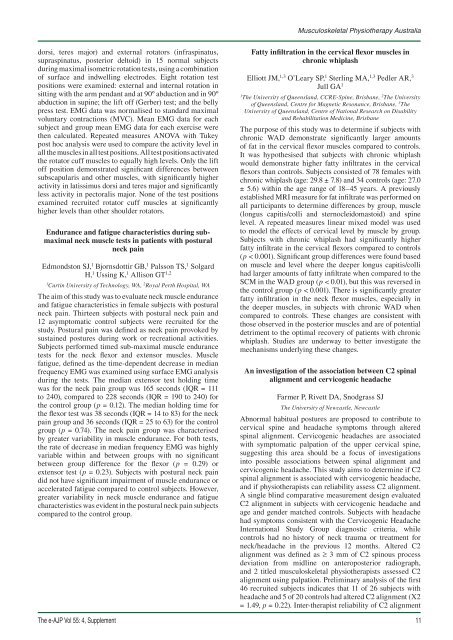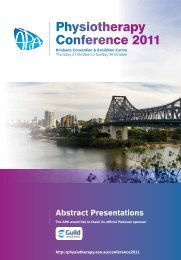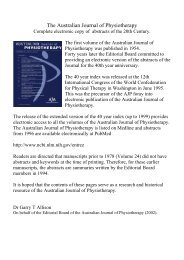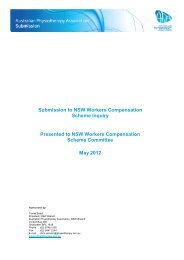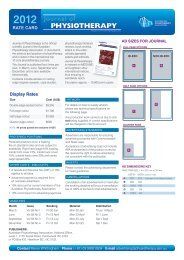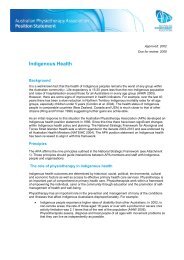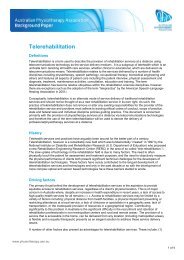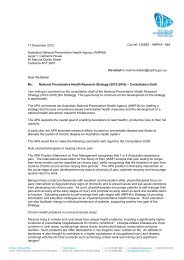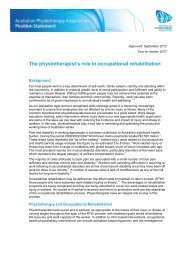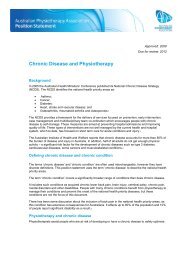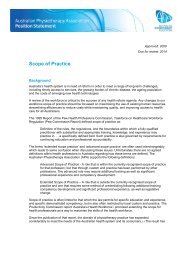2009 APA Conference Week Abstracts - Australian Physiotherapy ...
2009 APA Conference Week Abstracts - Australian Physiotherapy ...
2009 APA Conference Week Abstracts - Australian Physiotherapy ...
You also want an ePaper? Increase the reach of your titles
YUMPU automatically turns print PDFs into web optimized ePapers that Google loves.
Musculoskeletal <strong>Physiotherapy</strong> Australia<br />
dorsi, teres major) and external rotators (infraspinatus,<br />
supraspinatus, posterior deltoid) in 15 normal subjects<br />
during maximal isometric rotation tests, using a combination<br />
of surface and indwelling electrodes. Eight rotation test<br />
positions were examined: external and internal rotation in<br />
sitting with the arm pendant and at 90º abduction and in 90º<br />
abduction in supine; the lift off (Gerber) test; and the belly<br />
press test. EMG data was normalised to standard maximal<br />
voluntary contractions (MVC). Mean EMG data for each<br />
subject and group mean EMG data for each exercise were<br />
then calculated. Repeated measures ANOVA with Tukey<br />
post hoc analysis were used to compare the activity level in<br />
all the muscles in all test positions. All test positions activated<br />
the rotator cuff muscles to equally high levels. Only the lift<br />
off position demonstrated significant differences between<br />
subscapularis and other muscles, with significantly higher<br />
activity in latissimus dorsi and teres major and significantly<br />
less activity in pectoralis major. None of the test positions<br />
examined recruited a rotator cuff muscles bat<br />
significantly<br />
higher levels than other shoulder rotators.<br />
Endurance and fatigue characteristics during submaximal<br />
neck muscle tests in patients with postural<br />
neck pain<br />
Edmondston SJ, 1 Bjornsdottir GB, 1 Palsson TS, 1 Solgard<br />
H, 1 Ussing K, 1 Allison GT 1,2<br />
1<br />
Curtin University of Technology, WA, 2 Royal Perth Hospital, WA<br />
The aim of this study was to evaluate neck muscle endurance<br />
and fatigue characteristics in female subjects with postural<br />
neck pain. Thirteen subjects with postural neck pain and<br />
12 asymptomatic control subjects were recruited for the<br />
study. Postural pain was defined as neck pain provoked by<br />
sustained postures during work or recreational activities.<br />
Subjects performed timed sub-maximal muscle endurance<br />
tests for the neck flexor and extensor muscles. Muscle<br />
fatigue, defined as the time-dependent decrease in median<br />
frequency EMG was examined using surface EMG analysis<br />
during the tests. The median extensor test holding time<br />
was for the neck pain group was 165 seconds (IQR = 111<br />
to 240), compared to 228 seconds (IQR = 190 to 240) for<br />
the control group (p = 0.12). The median holding time for<br />
the flexor test was 38 seconds (IQR = 14 to 83) for the neck<br />
pain group and 36 seconds (IQR = 25 to 63) for the control<br />
group (p = 0.74). The neck pain group was characterised<br />
by greater variability in muscle endurance. For both tests,<br />
the rate of decrease in median frequency EMG was highly<br />
variable within and between groups with no significant<br />
between group difference for the flexor (p = 0.29) or<br />
extensor test (p = 0.23). Subjects with postural neck pain<br />
did not have significant impairment of muscle endurance or<br />
accelerated fatigue compared to control subjects. However,<br />
greater variability in neck muscle endurance and fatigue<br />
characteristics was evident in the postural neck pain subjects<br />
compared to the control group.<br />
Fatty infiltration in the cervical flexor muscles in<br />
chronic whiplash<br />
Elliott JM, 1,3 O’Leary SP, 1 Sterling MA, 1,3 Pedler AR, 3<br />
Jull GA 1<br />
1<br />
The University of Queensland, CCRE-Spine, Brisbane, 2 The University<br />
of Queensland, Centre for Magnetic Resonance, Brisbane, 3 The<br />
University of Queensland, Centre of National Research on Disability<br />
and Rehabilitation Medicine, Brisbane<br />
The purpose of this study was to determine if subjects with<br />
chronic WAD demonstrate significantly larger amounts<br />
of fat in the cervical flexor muscles compared to controls.<br />
It was hypothesised that subjects with chronic whiplash<br />
would demonstrate higher fatty infiltrates in the cervical<br />
flexors than controls. Subjects consisted of 78 females with<br />
chronic whiplash (age: 29.8 ± 7.8) and 34 controls (age: 27.0<br />
± 5.6) within the age range of 18–45 years. A previously<br />
established MRI measure for fat infiltrate was performed on<br />
all participants to determine differences by group, muscle<br />
(longus capitis/colli and sternocleidomastoid) and spine<br />
level. A repeated measures linear mixed model was used<br />
to model the effects of cervical level by muscle by group.<br />
Subjects with chronic whiplash had significantly higher<br />
fatty infiltrate in the cervical flexors compared to controls<br />
(p < 0.001). Significant group differences were found based<br />
on muscle and level where the deeper longus capitis/colli<br />
had larger amounts of fatty infiltrate when compared to the<br />
SCM in the WAD group (p < 0.01), but this was reversed in<br />
the control group (p < 0.001). There is significantly greater<br />
fatty infiltration in the neck flexor muscles, especially in<br />
the deeper muscles, in subjects with chronic WAD when<br />
compared to controls. These changes are consistent with<br />
those observed in the posterior muscles and are of potential<br />
detriment to the optimal recovery of patients with chronic<br />
whiplash. Studies are underway to better investigate the<br />
mechanisms underlying these changes.<br />
An investigation of the association between C2 spinal<br />
alignment and cervicogenic headache<br />
Farmer P, Rivett DA, Snodgrass SJ<br />
The University of Newcastle, Newcastle<br />
Abnormal habitual postures are proposed to contribute to<br />
cervical spine and headache symptoms through altered<br />
spinal alignment. Cervicogenic headaches are associated<br />
with symptomatic palpation of the upper cervical spine,<br />
suggesting this area should be a focus of investigations<br />
into possible associations between spinal alignment and<br />
cervicogenic headache. This study aims to determine if C2<br />
spinal alignment is associated with cervicogenic headache,<br />
and if physiotherapists can reliability assess C2 alignment.<br />
A single blind comparative measurement design evaluated<br />
C2 alignment in subjects with cervicogenic headache and<br />
age and gender matched controls. Subjects with headache<br />
had symptoms consistent with the Cervicogenic Headache<br />
International Study Group diagnostic criteria, while<br />
controls had no history of neck trauma or treatment for<br />
neck/headache in the previous 12 months. Altered C2<br />
alignment was defined as ≥ 3 mm of C2 spinous process<br />
deviation from midline on anteroposterior radiograph,<br />
and 2 titled musculoskeletal physiotherapists assessed C2<br />
alignment using palpation. Preliminary analysis of the first<br />
46 recruited subjects indicates that 11 of 26 subjects with<br />
headache and 5 of 20 controls had altered C2 alignment (X2<br />
= 1.49, p = 0.22). Inter-therapist reliability of C2 alignment<br />
The e-AJP Vol 55: 4, Supplement 11


